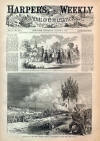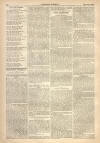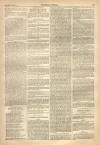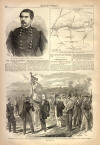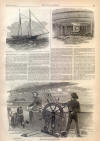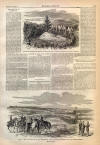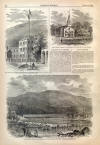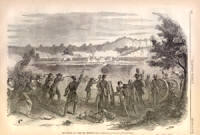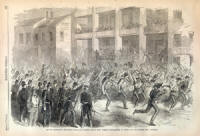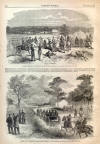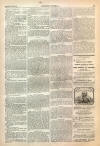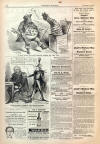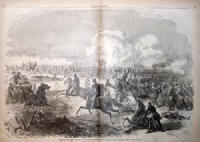Civil War Weapons
|
|
This Site:
|
AUGUST 3, 1861.] HARPER'S WEEKLY. 495 "No, no," said Biddy, gently. "You must marry." " So Herbert and Clara say, but I don't think I shall, Biddy. I have so settled down in their home, that it's not at all likely. I am already quite an old bachelor." Biddy looked down at her child, and put its little hand to her lips, and then put the good matronly hand with which she had touched it into mine. There was something in the action and in the light pressure of Biddy's wedding-ring that had a very pretty eloquence in it. "Dear Pip," said Biddy, "you are sure you don't fret for her?" " Oh no-I think not, Biddy." "Tell me, as an old, old friend. Have you quite forgotten her ?" " My dear Biddy, I have forgotten nothing in my life that ever had a foremost place there, and little that ever had any place there. But that poor dream, as I once used to call it, has all gone by, Biddy, all gone by!" Nevertheless, I knew while I said those words that I secretly intended to revisit the site of the old house that evening alone for her sake. Yes, even so. For Estella's sake. I had heard of her as leading a most unhappy life, and as being separated from her husband, who had used her with great cruelty, and who had become quite renowned as a compound of pride, avarice, brutality, and meanness. And I had heard of the death of her husband, from an accident consequent on his ill-treatment of a horse. This release had befallen her some two years before ; for any thing I knew she was married again. The early dinner-hour at Joe's left me abundance of time, without hurrying my talk with Biddy, to walk over to the old spot before dark. But what with loitering on the way, to look at old objects and to think of old times, the day had quite declined when I came to the place. There was no house now, no brewery, no building whatever left, but the wall of the old garden. The cleared space had been inclosed with a rough fence, and, looking over. it, I saw that some of the old ivy had struck root anew, and was growing green on low, quiet mounds of ruin. A gate in the fence standing ajar, I pushed it open and went in. A cold, silvery mist had veiled the afternoon, and the moon was not yet up to scatter it ; but the stars were shining beyond the mist, and the moon was coming, and the evening was not dark. I could trace out where every part of the old house had been, and where the brewery had been, and where the gates, and where the casks. I had done so, and was looking along the desolate garden-walk, when I beheld a solitary figure in it. The figure showed itself aware of me as I advanced. It had been moving toward me, but it stood still. As I drew nearer I saw it to be the figure of a woman. As I drew nearer yet, it was about to turn away, when it stopped, and let me come up with it. Then it faltered, as if much surprised, and uttered my name, and I cried out, "Estella!" " I am greatly changed. I wonder you know me." The freshness of her beauty was indeed gone, but its indescribable majesty and its indescribable charm remained. Those attractions in it I had seen before ; what I had never seen before was the saddened, softened light of the once proud eyes ; what I had never felt before was the friendly touch of the once insensible hand. We sat down on a bench that was near, and I said, " After so many years, it is strange that we should thus meet, again, Estella, here where our first meeting was! Do you often come back ?" " I have never been here since." "Nor I." The moon began to rise, and I thought of the placid look at the white ceiling, which had passed away. The moon began to rise, and I thought of the pressure on my hand when I had spoken the last words he had heard on earth. Estella was the next to break the silence that ensued between us. "I have very often hoped and intended to come back, and have been prevented by many circumstances. Poor, poor old place !" The silvery mist was touched with the first rays of the moonlight, and the same rays touched the tears that dropped from her eyes. Not knowing that I saw them, and setting herself to get the better of them, she said, quietly, " Were you wondering, as you walked along, how it came to be left in this condition ?" " Yes, Estella." "The ground belongs to me. It is the only possession I have not relinquished. Every thing else has gone from me, little by little, but I have kept this It was the subject of the only determined resistance I made in all the wretched years." "Is it to be built on?" "At last it is. I came here to take leave of it before its change. And you," she said, in a voice of touching interest to a wanderer, "you live abroad still?" "Still." " And do well, I am sure ?" "I work pretty hard for a sufficient living, and therefore—Yes, I do well." "I have often thought of you," said Estella. " Have you?" " Of late, very often. There was a long hard time when I kept far from me the remembrance of what I had thrown away when I was quite ignorant of its worth. But since my duty has not been incompatible with the admission of that remembrance, I have given it a place in my heart." " You have always held your place in my heart," I answered. And we were silent again, until she spoke. " I little thought," said Estella, " that I should take leave of you in taking leave of this spot. I am very glad to do so." " Glad to part again, Estella ? To me, parting is a painful thing. To me, the remembrance of our last parting has been ever mournful and painful." " But you said to me," returned Estella, very earnestly, " 'God bless you, God forgive you !' And if you could say that to me then, you will not hesitate to say that to me now—now, when suffering has been stronger than all other teaching, and has taught me to understand what your heart used to be. I have been bent and broken, but—I hope—into a better shape. Be as considerate and good to me as you were, and tell me we are friends." We are friends," said I, rising and bending over her, as she rose from the bench. "And will continue friends apart," said Estella. I took her hand in mine, and we went out of the ruined place ; and as the morning mists had risen long ago when I first left the forge, so the evening mists were rising now, and in all the broad expanse of tranquil light they showed to me, I saw the shadow of no parting from her. THE END. CONCERNING FIRE-ARMS.THE existence of the present warlike condition of affairs in this country will naturally turn the attention of all classes of people to the instruments with which the question at issue is to be solved. A peaceful nation like the American is better acquainted with the manufacture and uses of the plow, the spade, and the harrow, than with those deadly weapons of war which we have now to weld and to wield. Very few know any thing about arms, and as every one is liable to be called upon to converse about them, if not to bear them, some description of those which may probably be brought into service during the present war will not be inappropriate or uninteresting. REVOLVING PISTOLS.Colt's revolving pistols have become so universally known of late years that any description of them is superfluous; where pistols are used they will be the regulation arm. At present it is almost impossible to purchase them at any reasonable price, the army pattern selling for $27. Another very good revolving pistol is North's patent, made by the Savage Revolving Fire-arm Co., at Middletown, Connecticut. They are sold for $20, army size. A new modification of the pistol, called the " Young America," consists of an arrangement by which, with one barrel, you are enabled to obtain two discharges, the barrel having two separate loads, each charge being reached by a separate hammer and cap. The pistol is very small, and an extremely effective little weapon. OLD STYLE OF MUSKETS.Until the year 1855 the regulation arm for United States Infantry was the smooth-bored musket, probably as inefficient a weapon as could be devised. The smooth barrel, highly polished, being absolutely impossible to sight over with any degree of accuracy, while its carrying power was by no means great. Since 1855 these arms have been rifled, and patent sights attached, making them at present very effective ; they carry the Minie bullet. Now there are two points with regard to which people have very various ideas ; and one of these is concerning rifles. And in order to instruct a great mass of individuals who would be ashamed to confess their ignorance, and greatly surprised if they knew how many shared it, we will give as simple an idea of the process of rifling as possible. RIFLING GUN-BARRELS.To rifle a gun-barrel from four to six grooves are cut upon the interior of the barrel, extending longitudinally through from end to end. These grooves are in depth about equal to the thickness of the finger-nail. Commencing parallel to each other, they presently take what is termed the gaining twist, and run spirally, still holding their relative positions, to the muzzle. Thus a succession of threads like a screw are formed, around which the ball is forced, and by reason of its spiral motion is of course propelled both with greater accuracy and greater force, and these last are the advantages of rifling a gun-barrel. THE MINIE BALL.Next to describe the Minie ball—so called, though we have reason to believe the principle on which it is made was first discovered by N. Greener, gun-maker, of Birmingham, England, and afterward appropriated by M. Minie. The Minie bullet is a cone, hollowed at the base to the depth of about one-third of the height of the whole bullet; the cartridge is fastened to the base of the bullet, the whole inclosed in a paper cover, and is then placed in the barrel and rammed home. When the powder explodes it fills up the cavity in the bullet, expands the lead, and drives it into the grooves of the rifle, filling them completely air-tight. The bullet being greased, it slips along the grooves without sticking, otherwise the gun becomes leaded. This principle overcomes the windage, and avoids the necessity for forcing a large bullet into a small bore, which frequently resulted in bursting guns. SHARPE'S RIFLES.Another weapon, which has obtained considerable notoriety and reputation since the Kansas troubles, and will probably be brought into service during the present war, is the Sharpe's rifle. The peculiarity of this arm is that it is breech-loading. By means of appropriate mechanism, the end of the barrel in the stock slides down, leaving the barrel entirely open. The prepared cartridge and ball are inserted, the slide returned, and the loading is completed. Of course the operation is very much simplified and facilitated; but some objectionable features present themselves in the fact that the separation of the barrel permits the escape of gas when, the explosion takes place; that the mechanism is liable to derangement; the barrel requiring frequently to be cleaned; and finally, that the gun is more expensive than others which are more reliable. This gun costs about $45 with sabre-bayonet, which will be described elsewhere. ARMY MUSKETS.Of the army musket (rifled) of 1855, with clasp bayonet, there can be manufactured at Springfield from 1800 to 2000 per month; about 35,000 have already been turned out from that place, half of which are in the possession of the Confederate forces. The 7th, 12th, and 71st Regiments N. Y. S. M. are furnished with this arm, which can be supplied by the quantity at about $22.50 each. The Minie rifle, with sabre bayonet, costs $30. ENFIELD RIFLES.The Enfield rifle is so called from the place where these arms are manufactured. It differs from the Minie rifle in the reduction of the bore and in weight—the latter weighing 10 1/2 pounds, the former 9 pounds. With these exceptions they are similarly constructed. The Enfield manufactory turns out weekly 1100 stand of arms, employing 1300 men. The Enfield rifle costs $30. We have mentioned all the guns likely to be brought into use at present, and will devote a few lines to some description of the bowie-knife and sabre bayonet. BOWIE-KNIVES.The bowie-knife is usually from ten to fifteen inches in length, with a blade about two inches wide. It is said to owe its invention to an accident which occurred to Colonel Bowie during a battle with the Mexicans ; he broke his sword some fifteen inches from the hilt, and afterward used the weapon thus broken as a knife in hand-to-hand fights. This is a most formidable weapon, and is commonly in use in the West and Southwest. SABRE BAYONETS.The sabre bayonet was originally used by the French during the Revolution of 1798, but was afterward discarded ; it has since been adopted by their Chasseurs, and is used also by the German Jagers and the Zouaves ; with us it is usually attached to the Minie and Sharpe's rifle, in lieu of the old clasp bayonet. In size it is similar to the artillery sword, being about eighteen inches long, with a cross hilt; it is, however, curved at the point like a sabre, but very slightly; a second curve, a few inches below, gives it a resemblance to a Malay creese. By an opening in the hilt it fits over the muzzle of the rifle, and by means of a spring attaches itself firmly to the barrel. When not in use it is carried in a sheath by the side. In Algiers and in Nicaragua it was used for cutting away brush and underwood, to facilitate the passage of artillery, or for other purposes. We have thus referred to the principal small- arms in common use which possess a history, of with whose construction the public may be supposed not to be familiar; we will therefore proceed to note the results of the investigations we have made into the subject of Ordnance. DIFFERENT KINDS OF ORDNANCE.Artillery—or, as it is usually termed, Ordnance —is, in modern warfare, divided into two classes : 1st, Siege Artillery, employed for attack and defense of fortified places, ships of war, etc.; and, 2d, Field Artillery, used in battle, or in the field-operations of armies. SIEGE ARTILLERY.Siege Artillery is composed of mortars, large howitzers, Paixhan guns, or Columbiads, and all cannon of a large calibre. In our service this class of ordnance includes 12, 18, 24, 32, and 42-pounder guns; 8, 10, and 13-inch mortars; 24-pound Carronades; and 8, 10, and 13-inch howitzers. All these, except the smaller mortars, are made of cast iron. MORTARS.Mortars are usually stationary, and are used for throwing iron shells filled with powder, and ignited by a fuse; bursting they produce great destruction. They are effective at distances of from one to three miles. HOWITZERS.The howitzer is a short, wide-mouthed piece of ordnance, calculated for throwing shells or balls, as may be desired, and discharged by means of a fuse. The calibre is much greater than that of cannon, though not so great as mortars ; it is very effective in siege and in resisting cavalry, as it can be used to throw canister or other projectiles, and is easily transported; only the larger size come under the head of siege-guns. The howitzer, or canon-obusier, was first introduced into the French service in 1824. PAIXHAN GUNS.Paixhan guns were invented by Colonel Bomford, of the United States Army ; but being introduced into the French service by General Paixhan, they received his name, although he had nothing to do with their invention; however, he afterward improved upon them. They were first used in the war of 1812, and attracted universal notice. These guns are of enormous size, having a calibre of 8, 10, and 12 inches. They are made with great thickness at the breech, to enable them to withstand a large charge of powder and heavy ball. The largest of these guns, the 12-inch, loads with twelve pounds of powder, and carries a hollow shot weighing 112 pounds; its extreme range is 1550 yards. The 8-inch gun carries a solid shot of 68 pounds, at an elevation of 15 degrees, 3250 yards. The Paixhan guns are used with traversing beds ; they are thus driven up an-inclined railway, with from 3 to 4 degrees elevation, after each discharge. The great use of these heavy guns is in fracturing and splintering, dismounting guns, etc. ; their range is usually not great. Captain Dahlgren, in his improvements of heavy ordnance, has carried still farther the principle involved in the Paixhan gun—that of strengthening the breech. His guns are now universally used on our ships of war, and his theories have been recognized in Europe as a great improvement in artillery manufacture. COLUMBIADS.Perhaps the gun most commonly named at the present time is the Columbiad, and yet the public is extremely ignorant as to its peculiarities. The Columbiad is of the class called Sea-coast Cannon, and combines in itself the qualities of the gun, howitzer, and mortar: in other words, it is a long-chambered piece of ordnance, having the capacity to project shot or shell, with heavy charges of powder, at high angles of elevation. It is, in fact, the Paixhan gun invented by Colonel Bomford, and which we have already mentioned. In 1844 the model of the Columbiad was changed, by lengthening the bore and increasing the weight of metal, to enable it to endure an increased charge of powder, or one-sixth the weight of the solid shot. Thus altered, they were found defective in strength, and in 1858 were degraded to the rank of shell guns, with diminished charges of powder. Their place has been supplied by a new model, having no base-ring nor swell of the muzzle. The 8-inch carries a 10-pound ball; the 10-inch carries a 16-pound ball. CARRONADES.Carronades derive their name from the Carron Foundery, in Scotland, where they were first cast in 1779 ; they are short, light, iron guns, differing from cannon and howitzers in having no trunnions, being fastened to their carriages by a loop underneath. They are chiefly used for arming ships, and enable vessels to throw heavy shot at close quarters without overloading their decks with heavy guns. On shore, Carronades are used in the same manner and for the same purposes as howitzers. [Field Artillery will be given in a future Number.] ADVERTISEMENTS.A SEQUEL TO " SCHOOL DAYS AT RUGBY." MESSRS. TICKNOR & FIELDS
PUBLISH THIS DAY,
Part Second, COMPLETING THE WORK. One handsome volume, 12mo, 430 pp., with fine Portrait of the Author, and Dedication for the American Edition. Price $1. Uniform with PART FIRST. Either volume or the complete work for sale by all booksellers, or sent, post paid, by the Publishers on receipt of price. 135 Washington St., Boston. SANDS' SARSAPARILLA will purify the system of all morbid matter, and impart to the blood such properties as to make it new, pure, and rich. Prepared and sold by A. B. & D. SANDS, No. 100 Fulton Street, New York. Army Express.—Adams's Express Company run daily Expresses to all the regiments. Packages for soldiers carried at half price. Office No. 59 Broadway.
H. WORCESTER'S
Manufactory & Salesrooms,
EMPLOYMENT.—ACTIVE, INTELLIGENT YOUNG MEN, who have been thrown out of situations by the War, can hear of EMPLOYMENT which, by proper efforts, can be made profitable, by addressingFOWLER AND WELLS, 308 Broadway, New York. Union Envelopes ! ! 100 varieties sent any where, on receipt of 50 cents in stamps. ALFRED S. ROBINSON, Publisher, Hartford. "Matrimony made Easy."—A new work, showing how either sex may be suitably married, irrespective of age or appearance, which can not fail—free for 25 cents. Address T. William & Co., Publishers, Box 2300, Philad. A NEW DISCOVERY. Men can make $5000 per year. Capital small. Applicants wanted. Address FRITZ & CO., Wellsburg, VA. WEDDING CARDS, Specimens by Mail on receipt of 2 postage stamps. EVERDELL 302'Broadway. N. Y. 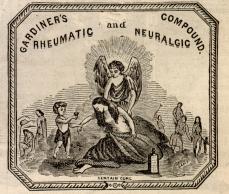 |
||||||||||||||||||||||||||||||||
|
|
||
|
|
Site Copyright 2003-2018 Son of the South. For Questions or comments about this collection, contact: paul@sonofthesouth.net |
|
|
Are you Scared and Confused? Read My Snake Story, a story of hope and encouragement, to help you face your fears. |
||
